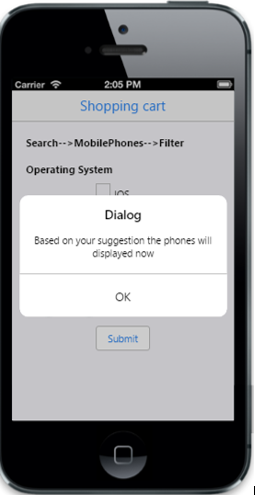Getting started
20 Feb 201711 minutes to read
Essential JavaScript Mobile Slider provides the selection of a single value or a range of values, using an interface with sliding handles. The following example shows you how to create a Shopping Cart App and through that learn the features in the Slider widget.
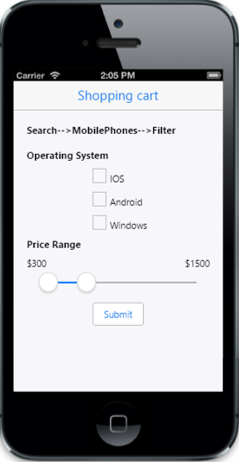
Create the layout for shopping cart app
Essential JS Mobile Slider widget is rendered by a <div> element with its required properties. You can customize Slider control by changing its properties according to your requirements. In the Shopping Cart App **, the **Range Slider is used to set the price range.
Create an HTML file and add the following template to the HTML file.
<!DOCTYPE html>
<html>
<head>
<title>Slider</title>
<link href="http://cdn.syncfusion.com/25.1.35/js/mobile/ej.mobile.all.min.css" rel="stylesheet" />
<script src="http://cdn.syncfusion.com/js/assets/external/jquery-3.0.0.min.js"></script>
<script src="http://cdn.syncfusion.com/25.1.35/js/mobile/ej.mobile.all.min.js"> </script>
</head>
<body>
<div id="page" data-role="appview">
<!-- header control -->
<div data-role="ejmheader" data-ej-title="Shopping cart">
</div>
<div id="content">
<div id="form" style="margin: 20px;">
<div>
<div>
<span class="text">Search-->MobilePhones-->Filter</span>
</div>
<br>
<span class="text">Operating System</span>
</div>
<!-- create check box for different OS -->
<div align="center" id="checkbox" style="margin-bottom: 10px">
<table border="0" cellpadding="6">
<tr>
<td>
<input id="ios" name="chkbox" data-role="ejmcheckbox" />IOS</td>
<td>
</tr>
<tr>
<td>
<input id="android" name="chkbox" data-role="ejmcheckbox" />Android</td>
</tr>
<tr>
<td>
<input id="windows" name="chkbox" data-role="ejmcheckbox" />Windows</td>
<td>
</tr>
</table>
</div>
<div style="margin-bottom: 10px">
<span class="text">Price Range</span>
</div>
<span id="minvalue" style="float: left;"></span>
<span id="maxvalue" style="float: right;"></span>
<div style="margin-top: 35px;">
<!—Add Slider control here-->
</div>
<div align="center" style="margin-top: 20px;">
<input type="button" data-role="ejmbutton" data-ej-text="Submit" id="button" data-ej-touchend="ShowDialog" />
</div>
<!-- dialog control -->
<div id="alertdlg" data-role="ejmdialog" data-ej-title="Dialog" data-ej-leftbuttoncaption="OK" data-ej-buttontap="alertClose">
<div id="dialogContent">Based on your suggestion the phones will displayed now </div>
</div>
</div>
</div>
<!-- ScrollPanel -->
<div data-role="ejmscrollpanel" data-ej-target="content"></div>
</div>
<style type="text/css">
span.text {
font-size: 15px;
font-weight: bold;
}
</style>
</body>
</html>Execute the above code example to render the following output.
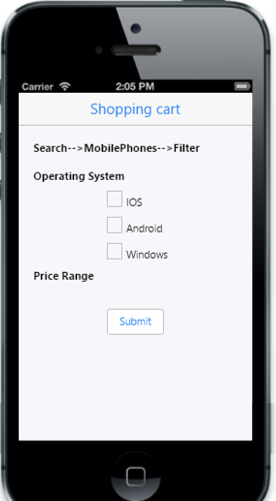
Create Slider control
To render Slider control, set ejmslider to data-role attribute to <div> element. Set 100 as the minimum value for the Slider using data-ej-minvalue, and set 5000 as the maximum value using data-ej-maxvalue. Set data-ej-incrementstep to 100 so that the slider is moved for every 100 values.
<!-- Slider control -->
<div id="slider" data-role="ejmslider" data-ej-minvalue="100" data-ej-maxvalue="5000" data-ej-incrementstep="100"></div>Run the above code example to render the following output.
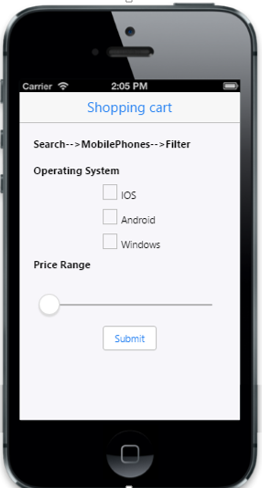
Create the Range Slider
You can set the price range using Range Slider. Set data-ej-enablerange attribute to “True”. You can set the initial range values by using data-ej-values attribute. Here, you can set the values as [300, 1500]. The Slider’s left thumb is set to 300 and the right thumb is set to 1500.
Add the following code to the Slider <div>.
<!-- Slider control -->
<div id="slider" data-role="ejmslider" data-ej-minvalue="100" data-ej-maxvalue="5000" data-ej-enablerange="true" data-ej-values="[300,1500]" data-ej-incrementstep="100"></div>Run the above code example to render the following output.
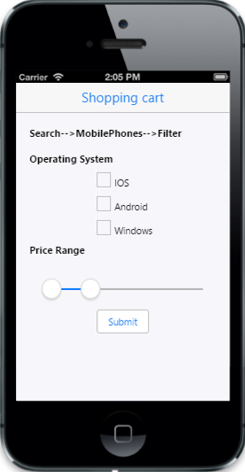
Handle events
In this scenario, when you change the Slider value, the corresponding values are updated to the element that acts as a label for Slider. You can use data-ej-slide event that is handled by appropriate function
Add the following code to the Slider <div>.
<!-- Slider control -->
<div id="slider" data-role="ejmslider" data-ej-minvalue="100" data-ej-maxvalue="5000" data-ej-enablerange="true" data-ej-values="[300,1500]" data-ej-slide="processOnSlide" data-ej-incrementstep="100"></div>From the Slider’s getValue API, you can get the present value of both the Slider handles, anytime. Add the following code example to the
//to display the slider value in span element (label) at initialize
$(function (args) {
window.dialogObject = $("#alertdlg").data("ejmDialog"); //to create dialog object
window.sliderObject = $("#slider").data("ejmSlider"); //to create slider object
setValue("300,1500");//set slider labels at initialize
});
// handling slider slide event
function processOnSlide() {
var value = sliderObject.getValue();// get the value of slider by using getValue API
setValue(value);
}
function setValue(value) {
var position = value.split(",");
$("#minvalue").html("$" + position[0]); //to set left thumb value to the left span
$("#maxvalue").html("$" +position[1]); // to set right thumb value to the right span
}
}Run the above code example to render the following output.

In this scenario, a dialog is displayed to provide information about the search when Submit is clicked. Add the following code to the **
//to display the slider value in span element (label) at initialize
//to open dialog
function ShowDialog(args) {
dialogObject.open(); //to show dialog
}
//to close dialog
function alertClose(args) {
dialogObject.close(); //close dialog
}Execute the above code example to render the following output, when you click Submit.
